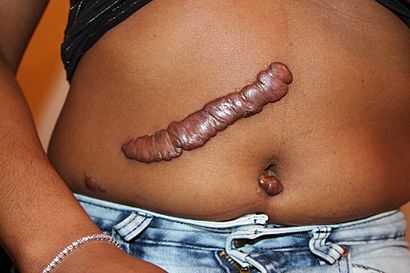Keloid facts for kids
Quick facts for kids Keloid |
|
|---|---|
 |
|
| A large keloid scar after stomach surgery | |
| Symptoms | Keloids expand in claw-like growths over normal skin |
A keloid is a special type of scar that forms after your skin has been hurt. It's also called keloid disorder or a keloidal scar. When your skin heals, sometimes it makes too much new tissue. This extra tissue creates a keloid.
Keloids are usually firm and feel a bit rubbery. They can also look shiny. Their color can be pink, red, dark brown, or the same color as your skin. A keloid scar is not harmful and you can't catch it from someone else. But sometimes, keloids can be very itchy or painful. They might also change how your skin feels. If a keloid is very big, it can even make it harder to move your skin. Keloid scars are much more common in people with darker skin tones. For example, they are seen 15 times more often in people from sub-Saharan Africa than in people from Europe.
What are Keloids and How Do They Look?
Keloids often grow outwards in a shape that looks like a claw. They spread over the healthy skin around the original injury. If a keloid gets infected, it might form an open sore.
Keloids form inside the scar tissue that develops after an injury. Your body uses something called collagen to help wounds heal. With keloids, too much collagen is made in one spot. This can create a lump that is much bigger than the first scar. Keloids can be pink or red. Most of the time, they appear where you had an injury. But sometimes, they can show up on their own without a clear reason.
Where Can Keloids Form?
Keloids can appear after a piercing. They can even form from something small, like a pimple or a scratch. Severe acne or chickenpox can also leave scars that turn into keloids. An infection in a wound can cause them too. Sometimes, keloids happen if an area of skin is hurt over and over. They can also form if there's a lot of tension on the skin when a wound is closing. If a foreign object gets stuck in a wound, that can also lead to a keloid. Some people find their keloids are sensitive to chlorine. If keloid scars appear when you are younger, they might keep growing because your body is still developing.
Images for kids
See also
 In Spanish: Queloide para niños
In Spanish: Queloide para niños




